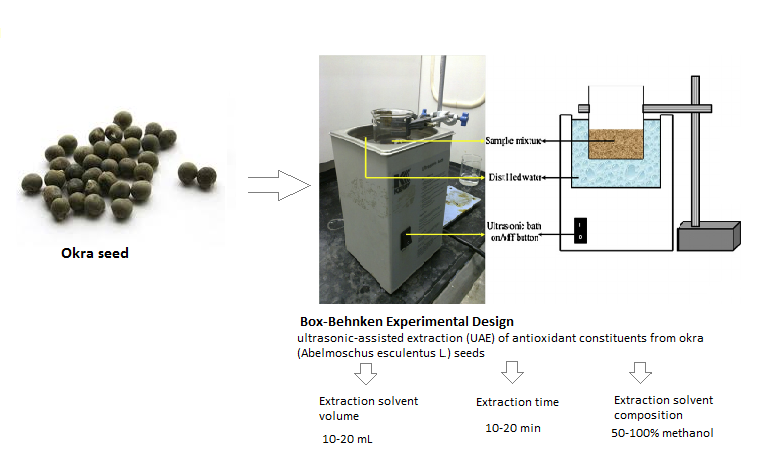JOURNAL 1742
Journal of Chemical Metrology
Year: 2020 Issue: 2 July-December
p.160 - 168
Viewed 2879 times.
GRAPHICAL ABSTRACT

ABSTRACT
Developments of food supplements and nutraceuticals from different natural origins require the use of some extraction methods. The success of the procedure relies on theefficiency of the extraction methods. Therefore, extraction methods need to be optimized. This work aimed for the determination of optimal conditions of ultrasonic-assisted extraction (UAE) of antioxidant constituents from okra (Abelmoschus esculentus L.) seeds which contain high contents of polysaccharides, polyphenols and flavonoids using response-surface methodology based on Box-Behnken experimental design (BBD). The independent variables of UAE were extraction time (Et, 10-20 min), extraction solvent composition (EC, 50-100% methanol) and extraction solvent volume (EV, 10-20 mL). 2,2-diphenyl-1-picrylhydrazyl (DPPH) radical-scavenging activity, 2,2'-azinobis- (3-ethylbenzothiazoline-6-sulfonic acid) (ABTS) radical-scavenging activity and N,N-dimethyl-p-phenylenediamine dihydrochloride (DMPD) radical-scavenging activity were dependent variables. Optimal extraction conditions for UAE from okra seed were: 20 mL volume of 70% methanol at 10 min extraction time for DPPH inhibition; 20 mL volume of 50% methanol at 20 min for ABTS inhibition; 15 mL volume of 55% methanol at 12 min for DMPD inhibition. Under these optimum extraction conditions, the effectiveness of UAE of okra seed was successfully revealed. So, this practical extraction technique can be widely used for the achievement of dietary supplements and nutraceuticals.
KEYWORDS- Abelmoschus esculentus L. seed
- okra
- ultrasound-assisted extraction
- box-Behnken Design
- response surface methodology